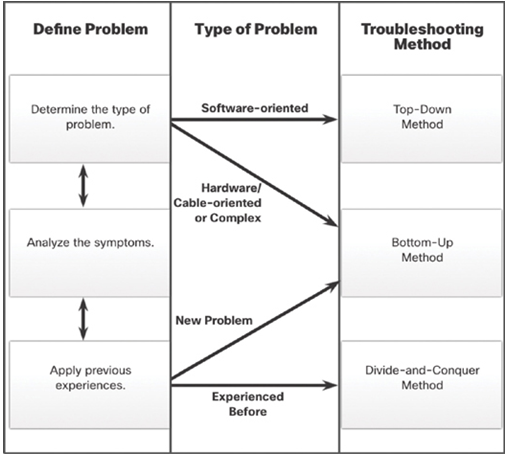Guidelines for Selecting a Troubleshooting Method (36.1.5)
To quickly resolve network problems, take the time to select the most effective network troubleshooting method.
Figure 36-4 illustrates which method could be used when a certain type of problem is discovered.

Figure 36-4 Selecting a Troubleshooting Method
For instance, software problems are often solved using a top-down approach, while hardware-based problems are solved using the bottom-up approach. New problems may be solved by an experienced technician using the divide-and-conquer method. Otherwise, the bottom-up approach may be used.
Troubleshooting is a skill that is developed by doing it. Every network problem you identify and solve adds to your skill set.
Check Your Understanding—The Troubleshooting Process (36.1.6)
Refer to the online course to complete this activity.
Physical Layer Problems (36.2)
A large proportion of networking problems are related to physical components or problems with the physical layer. Physical problems are concerned mainly with the hardware aspects of computers and networking devices, and the cables that interconnect them. Physical problems do not include the logical (software) configuration of devices.
Common Layer 1 Problems (36.2.1)
Remember, the physical layer (Layer 1) deals with the physical connectivity of the network devices. Some of the more common Layer 1 problems include the following:
- Device power turned off
- Device power unplugged
- Loose network cable connection
- Incorrect cable type
- Faulty network cable
- Faulty wireless access point
To troubleshoot at Layer 1, first check that all devices have the proper power supplied, and that the devices are turned on. This may seem to be an obvious solution, but many times the person reporting the problem may overlook a device that is within the network path from source to destination. Ensure there are no errors showing on any LEDs that display the connectivity status. If you’re on site, visually inspect all network cabling and reconnect cables to ensure a proper connection. If the problem is with wireless, verify that the wireless access point is operational and that wireless settings are configured correctly.
Vision is used to detect problems such as improperly connected or poorly constructed cables:
- Cables that are not connected
- Cables connected to the wrong port
- Loose cable connections
- Damaged cables and connectors
- Use of the wrong type of cable
Vision also allows us to view the condition and function of various network devices with LEDs.
Smell can alert troubleshooters to components that are overheating. The smell of burning insulation or components is very distinct and is a sure sign that something is seriously wrong.
The sense of taste is directly related to the sense of smell because both use the same receptors. You may also taste the acridness of something burning.
Troubleshooters can use touch to feel for overheated components as well as to detect mechanical problems with devices such as cooling fans. These devices usually create a small vibration in the component that can be detected using touch. The absence of this vibration or the presence of excessive amounts of vibration can indicate that the cooling fan has failed or is about to do so.
Hearing is used to detect major problems such as electrical issues and the proper operation of cooling fans and disk drives. All devices have characteristic sounds, and any change from the normal sounds usually indicates a problem of some sort.
